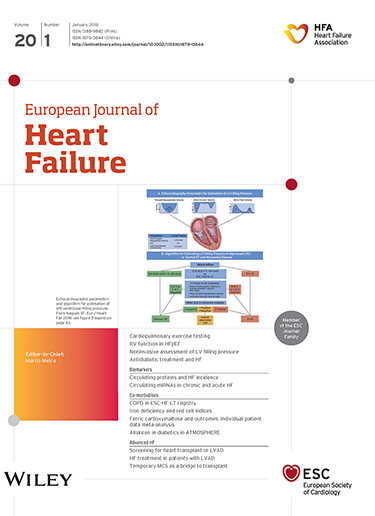Beta-blockers in patients with heart failure with reduced ejection fraction and concomitant chronic obstructive pulmonary disease: Cardiovascular and respiratory outcomes.
IF 10.8
1区 医学
Q1 CARDIAC & CARDIOVASCULAR SYSTEMS
引用次数: 0
Abstract
AIMS Patients with heart failure (HF) with reduced ejection fraction (HFrEF) and chronic obstructive pulmonary disease (COPD) are poorly represented in HFrEF trials testing beta-blockers. We assessed cardiovascular effectiveness and respiratory safety of beta-blockers in these patients. METHODS AND RESULTS Patients with HFrEF and COPD in the Swedish HF Registry (2006-2023) were included. Overlap-weighted models were used to assess associations between beta-blocker use and 5-year risk of outcomes, with cardiovascular death/total hospitalizations for HF (HHF) representing the primary cardiovascular effectiveness outcome, and total severe COPD exacerbations being the primary respiratory safety outcome. Of 5084 patients with HFrEF and COPD, median age was 75 years (interquartile range [IQR] 69-81), 68.3% were male, 36.9% were in GOLD group E, 91.5% used beta-blockers. Over a median follow-up of 2.5 years (IQR 1.0-4.8), beta-blocker users had lower crude risk of cardiovascular death/total HHF (rate ratio [RR] 0.66, 95% confidence interval [CI] 0.56-0.78) and total severe COPD exacerbations (RR 0.75, 95% CI 0.60-0.93). After overlap weighting, beta-blocker use was independently associated with lower risk of cardiovascular death/total HHF (RR 0.74, 95% CI 0.58-0.96) but not total severe COPD exacerbations (RR 0.99, 95% CI 0.73-1.35). These associations were consistent across subgroups (including GOLD groups), except for the greater magnitude of the association with lower risk of cardiovascular death/total HHF in patients with left ventricular ejection fraction <30% (p for interaction = 0.004). Falsification analyses suggested no influence from residual confounding. CONCLUSIONS In patients with HFrEF and COPD, beta-blocker use was associated with lower risk of cardiovascular death/total HHF, without evidence of safety concerns for COPD exacerbations.-受体阻滞剂在心力衰竭伴射血分数降低和慢性阻塞性肺疾病患者中的应用:心血管和呼吸结局
患有心力衰竭(HF)并射血分数降低(HFrEF)和慢性阻塞性肺疾病(COPD)的患者在HFrEF试验中测试β受体阻滞剂的比例较低。我们评估了-受体阻滞剂在这些患者中的心血管有效性和呼吸安全性。方法和结果纳入瑞典HF登记处(2006-2023)的HFrEF和COPD患者。重叠加权模型用于评估β受体阻滞剂使用与5年预后风险之间的关系,心血管死亡/ HF (HHF)住院总次数代表主要心血管有效性结局,而慢性阻塞性肺病严重加重总次数是主要呼吸安全性结局。5084例HFrEF合并COPD患者中位年龄为75岁(四分位数范围[IQR] 69-81), 68.3%为男性,36.9%为GOLD E组,91.5%使用β受体阻滞剂。在中位随访2.5年(IQR 1.0-4.8)中,β受体阻滞剂使用者心血管死亡/总HHF的粗风险(比率比[RR] 0.66, 95%可信区间[CI] 0.56-0.78)和总严重COPD加重(RR 0.75, 95% CI 0.60-0.93)较低。重叠加权后,β受体阻滞剂的使用与心血管死亡/总HHF风险降低独立相关(RR 0.74, 95% CI 0.58-0.96),但与总COPD严重加重风险无关(RR 0.99, 95% CI 0.73-1.35)。除了左心室射血分数<30%的患者心血管死亡/总HHF风险较低(相互作用p = 0.004)外,这些关联在各亚组(包括GOLD组)中是一致的。证伪分析表明,残余混杂没有影响。结论:在HFrEF和COPD患者中,β受体阻滞剂的使用与心血管死亡/总HHF风险降低相关,没有证据表明对COPD加重有安全性担忧。
本文章由计算机程序翻译,如有差异,请以英文原文为准。
求助全文
约1分钟内获得全文
求助全文
来源期刊

European Journal of Heart Failure
医学-心血管系统
CiteScore
27.30
自引率
11.50%
发文量
365
审稿时长
1 months
期刊介绍:
European Journal of Heart Failure is an international journal dedicated to advancing knowledge in the field of heart failure management. The journal publishes reviews and editorials aimed at improving understanding, prevention, investigation, and treatment of heart failure. It covers various disciplines such as molecular and cellular biology, pathology, physiology, electrophysiology, pharmacology, clinical sciences, social sciences, and population sciences. The journal welcomes submissions of manuscripts on basic, clinical, and population sciences, as well as original contributions on nursing, care of the elderly, primary care, health economics, and other related specialist fields. It is published monthly and has a readership that includes cardiologists, emergency room physicians, intensivists, internists, general physicians, cardiac nurses, diabetologists, epidemiologists, basic scientists focusing on cardiovascular research, and those working in rehabilitation. The journal is abstracted and indexed in various databases such as Academic Search, Embase, MEDLINE/PubMed, and Science Citation Index.
 求助内容:
求助内容: 应助结果提醒方式:
应助结果提醒方式:


